Curious About the 1993 Penny’s Worth? You’re in the Right Place!
If you’ve been wondering how much a 1993 penny is worth, this guide will walk you through everything you need to know. We’ll take a look at its background and design, and more importantly, explain what makes certain examples more valuable to collectors.
Let’s dive in and see what sets some of these coins apart!
1993 Penny Value Table
| Mint Mark | XF45 | MS63 | MS67 | MS69 |
|---|---|---|---|---|
| 1993 (No Mint Mark – Philadelphia) | 1 cent | $4 | $24 | $4,250 |
| 1993 D (Denver) | 1 cent | $6 | $28 | $2,500 |
| Mint Mark | PR60 | PR65 | PR68 | PR70 |
|---|---|---|---|---|
| 1993 S Proof (San Francisco) | 1 cent | $4 | $6 | $38 |
All values are based on coins with a red color designation — the most desirable type for Lincoln cents among collectors.
History of the 1993 Penny

The 1993 penny is part of the long-running Lincoln cent series, specifically from the modern chapter that started in 1959.
This coin gets its name from the iconic image of Abraham Lincoln on the front side. His portrait first appeared on a U.S. coin in 1909, marking 100 years since his birth. This wasn’t just a tribute—it was also a groundbreaking move in American numismatics.
Before Lincoln’s debut, U.S. coins typically featured symbolic figures like Lady Liberty. Unlike European coins, which often portrayed reigning monarchs, American designs had avoided real people. But in 1909, that changed. Public enthusiasm for honoring Lincoln led to the decision to put his face on the penny, and the task of designing the coin went to Victor David Brenner.
The earliest Lincoln cents had a reverse side decorated with two wheat ears, known today as “Wheat Pennies.” But in 1959, for the 150th anniversary of Lincoln’s birth, the Mint updated the design. They replaced the wheat with an image of the Lincoln Memorial, the same design you’ll find on the back of the 1993 penny.
The coin’s composition has also evolved over time. Originally, Lincoln pennies were made from bronze—a mix of 95% copper and 5% tin and zinc. But in 1943, due to wartime copper shortages, the Mint issued pennies made of zinc-coated steel. This steel cent was short-lived, and by 1944, the coin returned to its bronze formula.
A more lasting change came in 1982, when the Mint switched materials again. Since then, pennies have been made from a zinc core coated in a thin layer of copper. That’s the exact formula used for the 1993 penny, and it’s still in use today.
You can even feel the difference. Compare a pre-1982 penny to one from 1993, and you’ll notice the newer one is much lighter. Drop them both on a wooden table, and you’ll hear it too—the older, heavier coin gives off a metallic ring, while the newer one has a duller, almost plastic-like thud.
Features of the 1993 Penny
The Obverse of the 1993 Penny
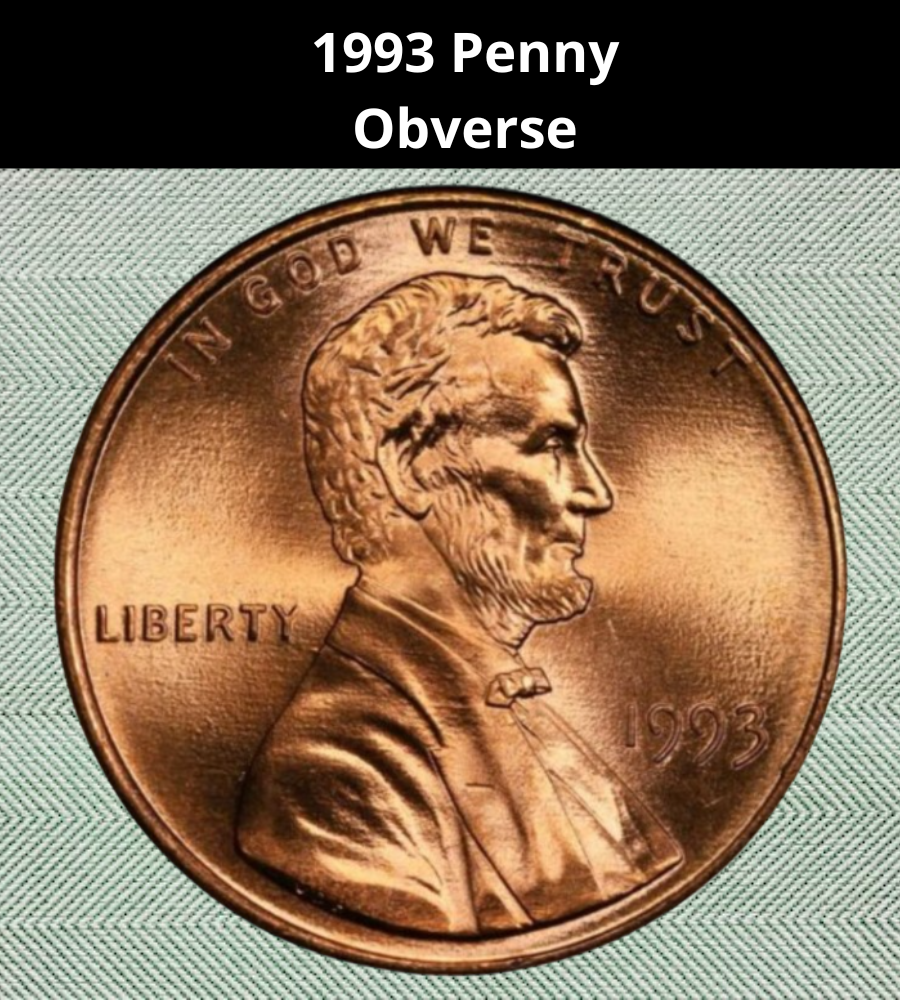
The front side (or obverse) of the 1993 penny features a portrait that every American coin user is likely to recognize: Abraham Lincoln, whose image has appeared on the cent since 1909. That makes it the longest-running coin design in U.S. history.
The artist behind this portrait was Victor David Brenner, an immigrant from the Russian Empire—specifically from the region that is now Lithuania. Coming from a family of metalworkers, Brenner began his artistic journey at a young age, developing a passion for engraving and sculpture.
He moved to the United States in the late 1800s, where he gained recognition for sculpting Theodore Roosevelt on a commemorative medal for the Panama Canal. Roosevelt, impressed by Brenner’s talent, likely played a key role in selecting him to design the new Lincoln penny.
Brenner’s design shows Lincoln in right-facing profile, displaying only his head and shoulders. If you look carefully at the base of the bust, you’ll notice the artist’s initials, “V.D.B.”—but they haven’t always been there.
Originally, Brenner had planned to sign the front of the coin, but the U.S. Mint rejected the idea. Instead, his initials were placed on the reverse. When the first 1909 pennies were released, however, the large initials caused a stir. Critics felt they looked like self-promotion or advertising. As a result, the Mint temporarily halted production and decided to remove the initials entirely.
It wasn’t until 1918 that Brenner’s initials returned—this time, discreetly placed on the obverse, right where they remain on today’s Lincoln cents.
The rest of the design includes the motto “IN GOD WE TRUST” above Lincoln’s head, the word “LIBERTY” to the left, and the minting year (“1993”) on the right. If your penny has a mint mark, it will appear just below the date.
Coins struck in:
- Philadelphia: have no mint mark
- Denver: show a “D”
- San Francisco (proof coins): show an “S”
The Reverse of the 1993 Penny
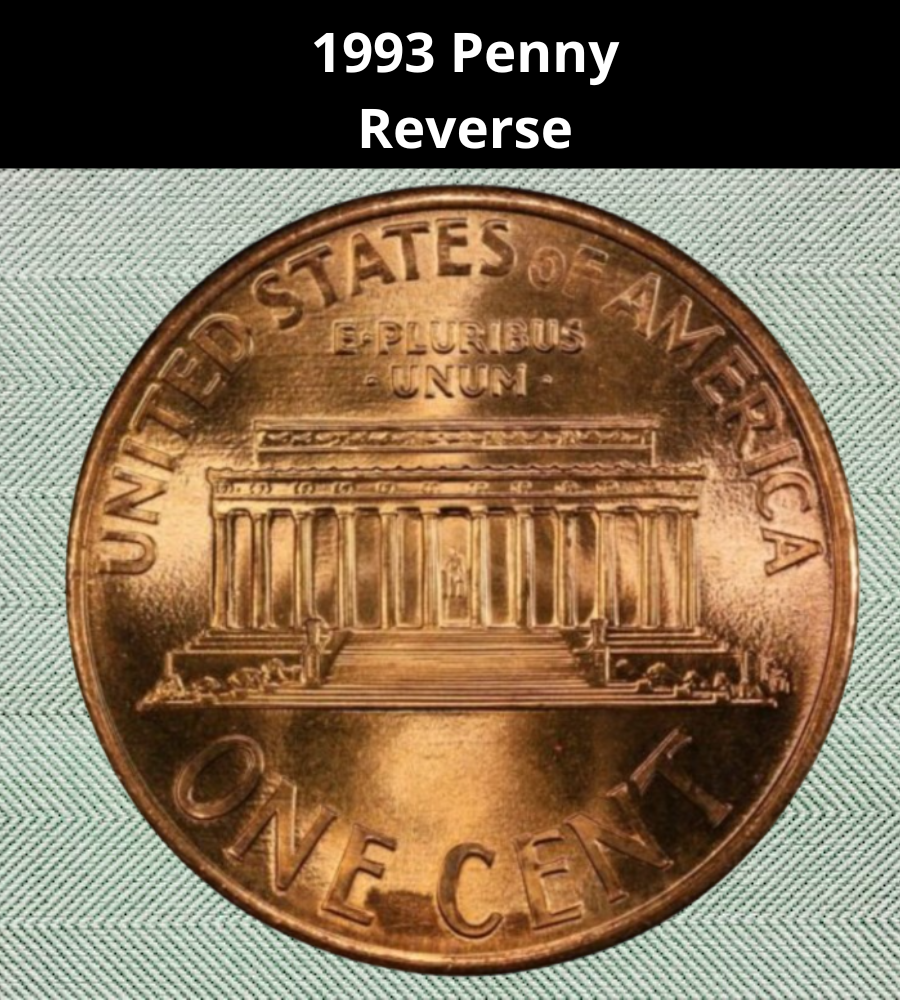
The reverse of the 1993 penny features the Lincoln Memorial, one of the most iconic landmarks in Washington, D.C.. If you look closely, you’ll see that the tiny image even includes a representation of the seated statue of Abraham Lincoln inside the memorial. This detail makes the coin unique—it’s one of the few U.S. coins that displays the same person on both sides.
This reverse design was introduced in 1959 to commemorate the 150th anniversary of Lincoln’s birth. It was crafted by Frank Gasparro, who at the time served as the Chief Engraver of the U.S. Mint. You can find his initials (FG) engraved on the lower right side of the memorial.
At the top edge of the coin, you’ll see “UNITED STATES OF AMERICA”, arched in a curve to match the rim. Just beneath that, above the structure’s roofline, is the motto “E PLURIBUS UNUM”—a Latin phrase meaning “Out of many, one”, symbolizing the unity of the original states into one nation.
Finally, at the bottom edge, the coin displays its face value, written as “ONE CENT”, also curved along the rim.
Other Details to Know About the 1993 Penny
Although the 1993 penny is mostly made of zinc, it’s coated with a thin layer of copper, and that outer layer can affect how the coin looks over time. When freshly minted, the copper gives the coin a bright reddish color. But as the penny ages or is handled, that color can shift to a more muted brown tone.
This color change isn’t just cosmetic—it’s actually an important factor in determining value. Professional coin grading services take the color of copper coins seriously, using it as one of the key indicators when assigning a grade.
The grading system divides Lincoln cents into three categories based on color:
- Red (RD): At least 95% of the surface area on both sides must retain the original red copper tone.
- Brown (BN): At least 95% of the coin has toned to a brown shade.
- Red-Brown (RB): Any coin that falls between those two extremes, with a mix of red and brown across its surface.
Coins graded as Red (RD) are usually the most desirable—and the most valuable—because they show minimal signs of age or exposure.
Understanding 1993 Penny Grading
When it comes to valuing your 1993 Lincoln penny, knowing its grade is absolutely essential. Grading refers to the coin’s overall condition, from heavily worn to flawless mint state.
Here’s a simplified breakdown of the grading scale:
| Grade Number | Grade Name |
|---|---|
| 1 | Basal State (Poor) |
| 2 | Fair |
| 3 | Very Fair |
| 4–6 | Good |
| 7–10 | Very Good |
| 12, 15 | Fine |
| 20, 30 | Very Fine |
| 40 | Extremely Fine |
| 50 | About Uncirculated |
| 60 | Mint State (MS-60) |
| 65 | Mint State (MS-65) |
| 70 | Perfect Mint State (MS-70) |
Coins that fall into the Mint State range (MS-60 to MS-70) are uncirculated and show no signs of wear, though they may still have small marks from the minting process. A perfect MS-70 coin is extremely rare and flawless under 5x magnification.
If you’re serious about finding out your coin’s value, checking its grade is the first and most important step. You can consult professional grading guides or services to get an accurate evaluation.
1993 Penny Value Guides
1993 No Mint Mark Penny Value
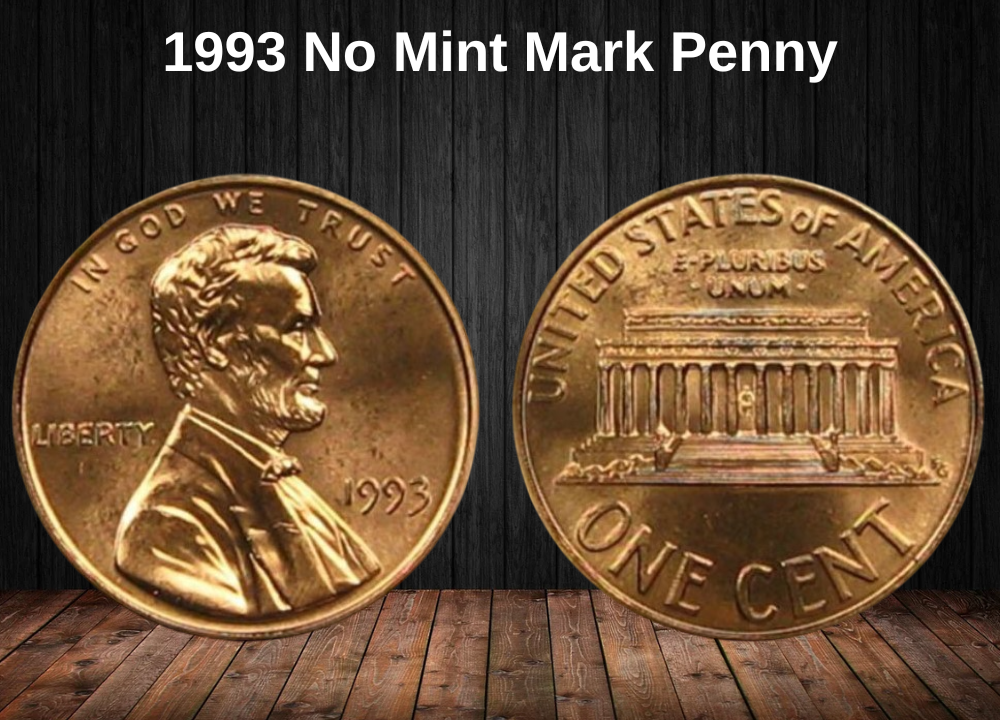
An enormous number of Lincoln pennies were produced at the Philadelphia Mint in 1993—a staggering total of nearly 5.7 billion coins. Despite the natural loss of coins over time, millions still survive in circulation or tucked away in drawers, making them very common today.
Because of this, most 1993 pennies without a mint mark are only worth their face value of one cent—unless they fall into a rare category, such as:
- Uncirculated coins in pristine condition, or
- Coins with unique mint errors.
Coins are graded on the 1 to 70 scale, where 1 represents a heavily worn, barely identifiable coin, and 70 means perfect quality, even under magnification. Uncirculated coins fall into the “Mint State” range, which covers grades from MS60 to MS70.
Even though many 1993 pennies exist in mint state, their abundance keeps values low—meaning it’s usually not worth paying for professional grading unless your coin is in exceptionally high condition.
Another big factor is color. To fetch higher prices, a 1993 penny needs to be graded as Red (RD)—meaning 95% or more of its original red copper color remains intact.
According to PCGS (Professional Coin Grading Service), here’s what a Red 1993 Philadelphia penny is worth at different Mint State grades:
- MS63 Red – $4
- MS64 Red – $5
- MS65 Red (Gem quality) – $8
- MS66 Red – $15
- MS67 Red – $24
- MS68 Red – $100
At the very top, only eight examples have been certified by PCGS at MS69 Red, and each is valued around $4,250—a true gem for any collector.
1993 D Penny Value

The Denver Mint actually produced even more 1993 pennies than Philadelphia, striking close to 6.5 billion coins. These can be easily spotted by the small “D” mint mark located just below the year on the coin’s obverse.
Because so many were made, most of these pennies hold little value beyond their face value of one cent. However, coins in mint state with high grades, as well as those with noteworthy minting errors, attract more interest from collectors.
For example, a red 1993 D penny graded MS63 carries a value of about $6 — that’s roughly 50% higher than a Philadelphia penny with the same grade.
If you have a coin graded MS65 red, its value jumps to around $10, while an MS67 red is worth approximately $28. At MS68, PCGS prices the coin at $65, increasing sharply to about $350 for coins graded MS68+.
At the very top end, there are 17 known examples graded MS69 red by PCGS. Although this is more than double the number certified for the no mint mark pennies, their prices are somewhat lower. Each of these MS69 red 1993 D pennies is valued at roughly $2,500.
1993 S Proof Penny Value
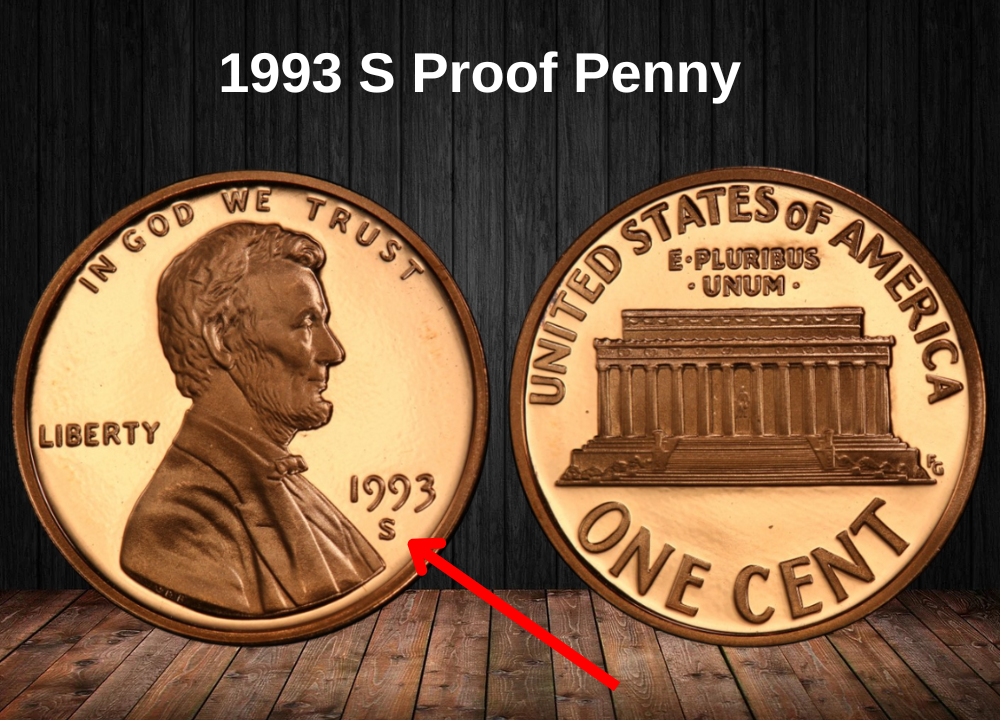
In 1993, while the Philadelphia and Denver Mints produced pennies for everyday use, the San Francisco Mint focused on crafting proof coins. These proofs are struck on specially polished blanks using specially prepared dies, designed to create coins with sharp details and mirror-like surfaces, primarily for coin collectors.
Though their total production was much smaller than the business strike pennies, the mintage was still substantial—nearly 3.4 million proof pennies were made in 1993.
Because proof coins are targeted at collectors and carefully stored, very few have been lost or circulated. This means it’s generally easy to find a high-quality 1993 S proof penny without paying a premium.
By definition, all proof coins are uncirculated, so their grading begins at PR60 (“PR” stands for proof). The 1993 S pennies also belong to the “deep cameo” category, known for a striking contrast between their mirror-like fields and frosted raised designs—the highest standard for proof coins.
Here’s a quick look at values based on grade for a 1993 S deep cameo proof penny:
- PR60 – roughly $1
- PR65 (Gem quality) – about $4
- PR69 (Near perfect) – around $14
At the time of writing, PCGS has graded over 9,000 pennies at the PR69 level.
For collectors seeking absolute perfection, a PR70 proof penny can be obtained for about $38, an excellent value for a flawless coin.
Rare 1993 Penny Errors List
1993 D Penny, Roosevelt Dime Reverse
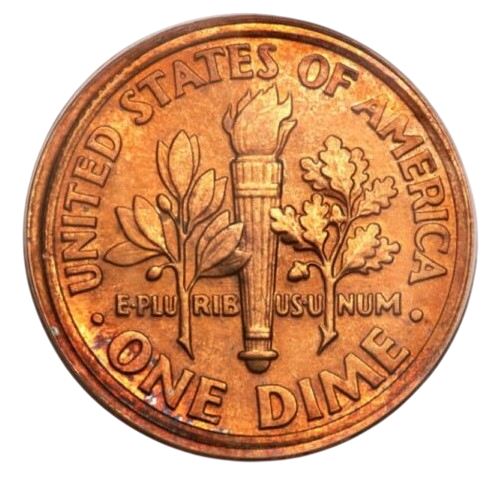
In 1993, a highly unusual error penny was accidentally struck at the Denver Mint. Instead of featuring the standard Lincoln Memorial design on the reverse, this coin was mistakenly struck with the reverse side of a Roosevelt dime. This dime design includes a torch flanked by an olive branch on one side and an oak branch on the other.
This error is exceptionally rare, and to make it even more remarkable, the coin was found in excellent condition, earning a grade of MS65 Red from the Professional Coin Grading Service (PCGS).
Because of its rarity and quality, when this coin went to auction, it commanded a staggering price of over $51,000.
1993 (P) No Mint Mark Penny, Double Struck, Second Strike Off-Center
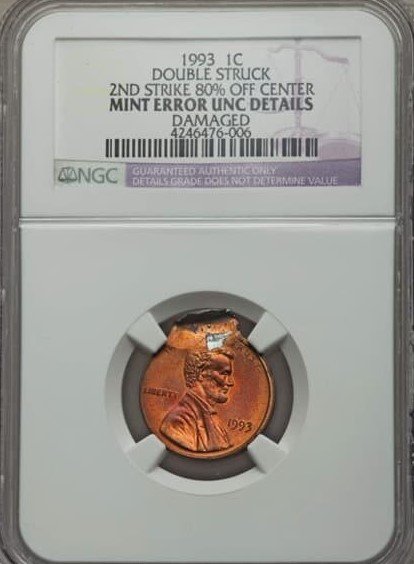
Sometimes, after a coin is struck, it doesn’t properly eject from the press and ends up being struck a second time. If the coin (or planchet) shifts position between strikes, the result is an off-center double strike—creating a very unusual appearance.
One notable example is a 1993 no mint mark penny that was double struck, with the second impression displaced by about 80% off-center.
Typically, such a dramatic mint error would boost a coin’s value significantly. However, this particular penny’s surface details were blurred and unclear, which caused the Numismatic Guaranty Corporation (NGC)—the grading authority—to withhold a numeric grade.
Due to the lack of a precise grade and the condition issues, this error penny sold at auction for a relatively modest $25.
Where to sell your penny?
Now that you know the value of your penny, you might be wondering where to sell it. Don’t worry: here’s a guide to some of the best online platforms where you can easily sell your coins, along with their advantages and disadvantages.
Discover the best platforms for selling coins online (pros and cons).
FAQs
1. What are the rarest varieties or errors found in the 1993 penny?
Answer: The 1993 penny has some notable error varieties, such as doubled dies and off-center strikes. While not extremely rare, these errors are highly sought after by collectors because they showcase minting anomalies that occurred during production. The doubled die obverse is one of the most recognized errors for this year.
2. How did the economic and social context of 1993 influence the production and circulation of pennies?
Answer: In 1993, the U.S. economy was recovering from a recession, which influenced coin production volumes. The penny remained essential for everyday transactions despite rising production costs. The Mint focused on maintaining quality and quantity to meet demand, especially as pennies continued to play a vital role in commerce.
3. What are the main differences between the 1993 pennies minted in Philadelphia and Denver?
Answer: The 1993 pennies minted in Philadelphia (no mint mark) and Denver (“D” mint mark) are nearly identical in design and composition, both made of copper-plated zinc. However, slight variations in striking pressure and die wear can create subtle differences. Collectors often seek both mint marks for a complete set.
4. What materials and techniques were used to mint the 1993 penny, and how have they affected its longevity?
Answer: The 1993 penny was struck using a core of 97.5% zinc with a 2.5% copper plating. This composition was chosen to reduce costs compared to the previous mostly copper pennies. While cost-effective, the zinc core makes pennies more prone to corrosion and wear if not properly cared for, affecting their condition over time.
5. How has the market value of the 1993 penny evolved over the years, and what factors influence its price?
Answer: Most 1993 pennies remain common and are valued mostly at face value unless they are error coins or in mint condition. Factors such as rarity of errors, condition (uncirculated vs. circulated), and collector demand influence prices. Over time, well-preserved specimens and rare varieties can fetch significantly higher prices.
6. What significance does the 1993 penny hold within specialized collections like Wheat Penny or Lincoln Cent sets?
Answer: Although the 1993 penny is not a Wheat Penny (which were minted until 1958), it is part of the Lincoln Memorial series. It holds value for collectors aiming to complete a full Lincoln Cent run. Its role is mostly as a common date but can become more interesting with certain errors or proof versions.
7. Are there any notable stories or discoveries related to 1993 pennies that have impacted the numismatic community?
Answer: While the 1993 penny hasn’t been the center of legendary discoveries like some older coins, the identification of doubled die errors in this year sparked interest. Such finds remind collectors to inspect even common coins carefully, as hidden varieties can exist and hold unexpected value.


















































